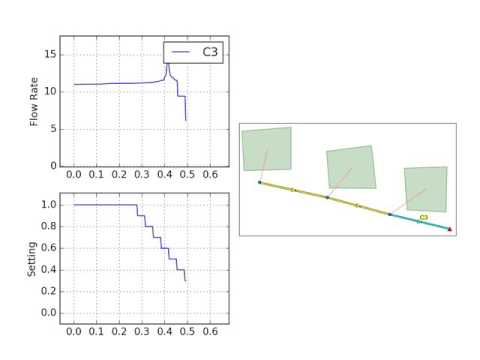Python Wrapper for SWMM5 API
Project description
Python Wrapper for Stormwater Management Model (SWMM5)
- Documentation
- Development
- PySWMM Wiki
Build status
Project information
YouTube Examples
Overview
PySWMM is a Python language software package for the creation, manipulation, and study of the structure, dynamics, and function of complex networks.
With PySWMM you can load and manipulate USEPA Stormwater Management Models. With the development of PySWMM, control algorithms can now be developed exclusively in Python which allows the use of functions and objects as well as storing and tracking hydraulic trends for control actions.
Who uses PySWMM?
PySWMM is used by engineers, modelers, and researchers who want to streamline stormwater modeling optimization, controls, and post-processing results.
Goals
PySWMM is intended to provide
tools for the study of the structure and dynamics within USEPA SWMM5,
a standard programming interface and graph implementation that is suitable for many applications,
a rapid development environment for collaborative, multidisciplinary projects,
an interface to USEPA SWMM5,
development and implementation of control logic outside of native EPA-SWMM Controls,
methods for users to establish their own node inflows,
a coding interface to binary output files,
new modeling possibilities for the SWMM5 Community.
Download
Get the latest version of PySWMM from https://pypi.python.org/pypi/pyswmm/
$ pip install pyswmm
To get the git version do
$ git clone https://github.com/OpenWaterAnalytics/pyswmm.git
Usage
A quick example that steps through a simulation:
Examples:
Intialize using with statement. This automatically cleans up after a simulation
>>> from pyswmm import Simulation
>>>
>>> with Simulation('model.inp') as sim:
... for ind in sim:
... pass
... sim.report()
Initialize the simulation and execute. This style does not allow the user to interact with the simulation. However, this approach tends to be the fastest.
>>> from pyswmm import Simulation
>>>
>>> sim = Simulation('model.inp')
>>> sim.execute()
Intialize a simulation and iterate through a simulation. This approach requires some clean up.
>>> from pyswmm import Simulation
>>>
>>> sim = Simulation('model.inp')
>>> for ind in sim:
... pass
>>>
>>> sim.report()
>>> sim.close()
Bugs
Our issue tracker is at https://github.com/OpenWaterAnalytics/pyswmm/issues. Please report any bugs that you find. Or, even better, fork the repository on GitHub and create a pull request. All changes are welcome, big or small, and we will help you make the pull request if you are new to git (just ask on the issue).
License
Distributed with a BSD2 license; see LICENSE.txt:
Copyright (C) 2014 PySWMM Developers Bryant E. McDonnell <bemcdonnell@gmail.com>
Powered By
Acknowledgements
Tim Cera
Assela Pathirana
Project details
Release history Release notifications | RSS feed
Download files
Download the file for your platform. If you're not sure which to choose, learn more about installing packages.
Source Distributions
Built Distribution
Hashes for pyswmm-0.4.7-py2.py3-none-any.whl
| Algorithm | Hash digest | |
|---|---|---|
| SHA256 | 0065ef2b05f31440611991c771905f260f2848cf7c3356c68926e386b385d445 |
|
| MD5 | 83065f7291b2deb40f2ae178a724edbd |
|
| BLAKE2b-256 | 3e8b52ed2f6962d05f8464a9255cd88c10572210ff288d77613d8499fe735105 |
























